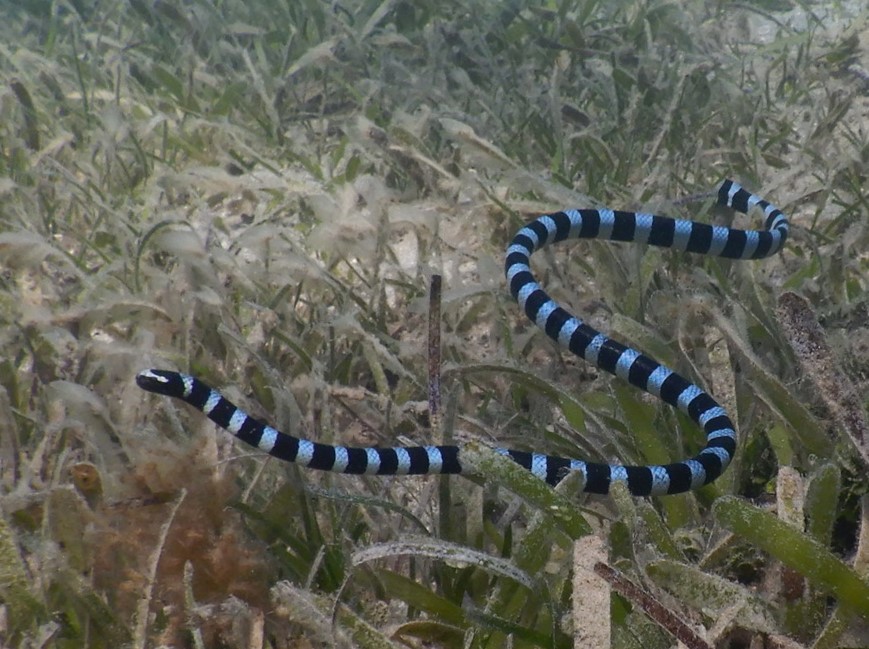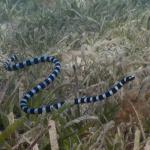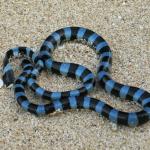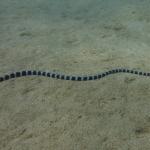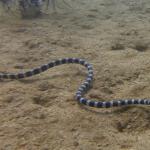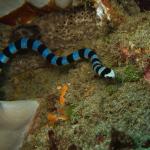- Home
- Herpetofauna Index
- Native
- Laticauda Laticaudata
Laticauda laticaudata
Brown-lipped sea krait
Laticauda laticaudata
(Linnaeus, 1758)
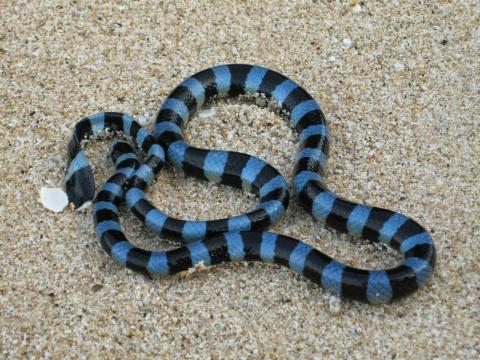
Length: Typically, 0.5-1m, but can reach lengths of up to 1.5m, with females being larger than males.
Weight: In adults between 0.2 and 0.5kg, with the males being lighter than the females.
Description
A stunning species of marine snake with beautiful deep blue, and black banding running along the entirety of its body, fading into pale yellow or cream on the undersides and on the facial mask. It has only been observed in New Zealand waters on one occasion.
This species is visually similar to the yellow-lipped sea krait, but can be distinguished by the presence of a brown upper lip as opposed to the yellow upper lip of the aforementioned species. Can be differentiated from the New Caledonian sea krait based on colouration (blue vs. brown) and number of black rings (35-54 vs. 25-39), and from the yellow-bellied sea snake by general morphology (blunt vs. flattened elongate head) and patterning (banded vs. striped).
Life Expectancy
Not known.
Distribution
The brown-lipped sea krait has a fairly wide distribution, occurring throughout the Indo-Pacific region from the eastern coast of India through to the coasts of China and southern Japan, and into the waters of New Caledonia, and the Solomon Islands in the western Pacific.
An extremely rare visitor to New Zealand, this species is only known from a single individual which turned up in Auckland.
Ecology and Habitat
A semi-aquatic species. The brown-lipped sea krait although still coming onto land to rest and nest is recognised as being less terrestrial than the other Laticauda species, rarely being found more than 5 metres from the ocean. They are often associated with the shallow waters surrounding islands, coral reefs, and mangroves where they can be seen hunting for prey at night but have been reported as diving to depths of over 80 metres when hunting in deeper waters. Although in general, they spend little time in the terrestrial environment, females tend to spend more time doing so than males do, although this is likely associated with reproductive factors.
Social Structure
This species is typically solitary, although they can be found in large aggregations on land, especially during the breeding season when several males can often be found courting lone females.
Breeding Biology
Brown-lipped sea kraits do not breed in New Zealand.
They are oviparous (egg-laying), with females (minimum of 88cm SVL) depositing clutches of between 1-7 eggs into sheltered crevices in the littoral zone from January to March. The young hatch out at around 38cm SVL, and 13 grams, after an incubation of approximately 3-4 months. Sexual maturity is reached at 1 ½-2 ½ years old.
Diet
Primarily an eel specialist, although they are known to prey upon other small fish species.
Most foraging excursions take place within a few kilometres of their home islands, with this species (at least where it co-occurs with the New Caledonian sea krait) preferentially focussing on soft-bottomed habitats (seagrass beds, mud flats, and sand), however, they have been recorded making excursions as far as 23km from their home island.
Disease
Brown-lipped sea kraits are host to several reptilian diseases and parasites including the sea snake tick (Amblyomma nitidum).
Conservation status
Listed as Not Threatened in the most recent threat classification for New Zealand reptiles, and as Least Concern under the IUCN criteria.
Interesting notes
Although highly venomous, they are non-aggressive, and thus it is extremely rare for envenomation to occur. Bites only occur when the animal is accidentally grabbed, and the animal bites in self-defence, as is the case when the animal is being removed from fishing nets.
It is possible that on occasion several of the sea krait species arrive in New Zealand on board private boats, as the animals have a tendency to climb into small spaces such as water intakes and exhaust pipes.
References
van Winkel, D., Baling, M., & Hitchmough, R. (2018). Reptiles and Amphibians of New Zealand: A Field Guide. Auckland University Press, pp376.

